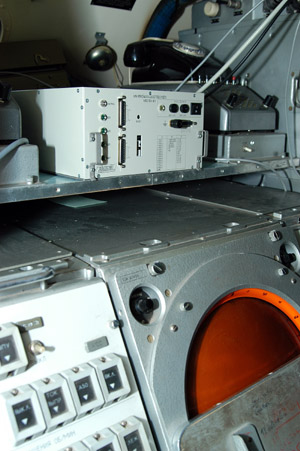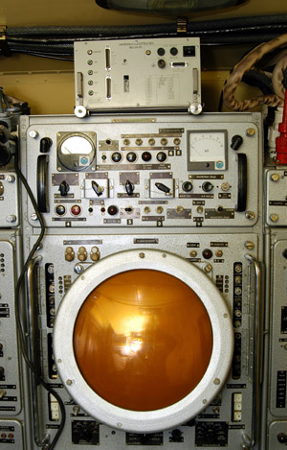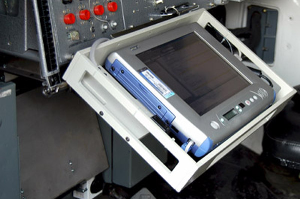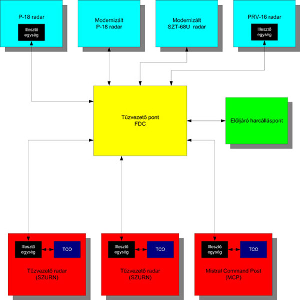Introduction
The K-1P fire control system came into existence with the moderization of the Russian made K-1M complex which is the automatic centralized fire control system of various Russian missile and conventional air defense systems.
The regimental command post of the original K-1M complex was the KBU shelter that received the orders of the superior KBU and the analog signals of the local radars. The regiment had no recognized air picture (RAP) at disposal, combat operations were based solely on local sensor data. The seven-strong combat crew evaluated the analog radar information and executed manual fire distribution.
The system sent target coordinates to the battery command post (KPC) through wire or radio connection.
The KPC received this telecode information and formed the neccessary analog control signals for the fire control radar (SZURN). After locking on the target the SZURN controlled the launchers and executed destruction independently.
Inadequacies of the original K-1M fire control system:
- Not able to receive NATO standard target designation data
- Not receives RAP data, so it can detect local air
situation with radar emission - Radars transmit only raw analogue picture, which demands
equipment and labour to receive, process and display, the
continuous tracking of targets is performed by operators manually - Cabling between equipment is complicated, deployment of the system is difficult
- Support of fire control is minimal, target distribution is performed by the Fire
- Distribution Officer
- There is no need for battery command level
- The technical level of equipment is obsolete, the number of failures is high

Main features of moderization
Modification of the K-1M complex to be suited to receive and process NATO standard data communication and fire control information
- At the command level where the K-1P system is integrated into the command and control system possibility of external control through Link11B protocol is also solved
- The system is constructed in such a way that it can be made suitable for controlling other air defense systems by replacing the fire control radar's interface unit (e.g. MISTRAL)
- Introduction of encrypted communication
- Computer aided fire distribution
- Removing the battery command post (KPC) for faster response
- Major improvement of the complex's availability time and reliability
- Simplification of deployment, reduction of number of connection cables
Universal interface device
The universal interface device implements all the necessary function to connect the elements of the K-1P complex. Simplifying logistic support has been a significant design goal that resulted in the installation of a common device on board of the various (fire control, surveillance and height-finding) radars. The interface has to contain all the necessary hardware and software to implement every function.
Functions of the universal interface device if installed in surveillance radars (P-18)
- Picture digitalization function. It processes the signals of analogue video channel of the surveillance radar and forwards the analogue picture in a digitalized way to the workplace of the sensor manager. The modification eliminates analogue indicator workplaces in the K-1P, but the content of the analogue picture may mean useful information for the SM for supervision purposes.
- Plot extractor function. It processes the signals of analogue video channel of the surveillance radar, shapes and forwards the synthetic air picture to the sensor manager's workplace in a digitalized way. This function supersedes the manual data input into the KBU computer used so far. The capacity of operators will not limit the number of targets the system can process and track.
Functions of the universal interface device if installed in height-finding radars (PRV-16)
- Remote controlled height-finding function. The radar has inputs suitable to receive target designations, but those can be controlled with special analogue rotation and range marker signals. In the target designation mode of the radar the interface device receives the signal proportionate to the actual azimuth of the antenna through the 8-wire rotation channel. The interface device generates an error signal from the difference of the actual azimuth and the azimuth of the searched target that the control system of the radar tries to work off, zeroing in the designated searching azimuth. There can be more targets in the given direction at one time, therefore the analogue voltage proportionate to range of the marker designates the object to measure for the operator who sets the height marker signal and with pressing a button signalizes to the electronics that the measuring is ready. After the automatic reading the measured data gets to the SM workplace, where the height becomes assigned to the track.
Functions of the universal interface device if installed in fire control radar (SZURN)
- Target track calculation function. The K-1P system continuously transmits the coordinates of the targets designated for destruction, but that rate of data refresh is not enough for the controlling of the fire control radar therefore the interface device calculates intermediate track positions by the available position direction and velocity information and performs the necessary parallax correction.
- Target designation function. Performs a target designation through the KPC control input of the SZURN by the received order and the calculated track data. Pointing happens in the same way as in the case of PRV-16 radars with passing over the azimuth error signal and the range marker.
- Communication mode. Connects to the radio/modem communication points through its synchronous/asynchronous serial communication channels, and forwards their converted data towards the TCO computer. Receives and forwards the reports of the TCO towards the K-1P.

Radars
The complex operates with local sensors, that transmitted signals suitable to drive PP indicators to the KBU before the modernization. During modernization the analogue video signal transmission of local radars have been ended, instead of that a new interface device has been installed that processes analogue video signals transmits plots and digitalized video signals through computer network for the SM.
The radar types can be applied are P-18, P-40, PRV-16 and SZT-68U. In case of using P-18 or SZT-68U radars modernized by HM Arzenál Co. there is no need for installing an auxiliary processing unit, because modernized radars provide the capability to fully cooperate with the K-1P system. These radars enable the SM to remotely control the working mode of them.


Fire control radar (SZURN)
The Battery Fire Control Officer's workplace is in the SZURN fire unit, where on the computer (TCO workplace) he/she can keep track of synthetic air picture formed in the FDC, receives orders (SSTO and engagement), and sends reports to the FDC (SSREP and engagement). The receipt of air picture enables to observe and track targets without radar emission. In automatic mode the equipment receives control signals from the universal interface device installed as the replacement of KPC shelter that locks it on the target in elevation and azimuth. The covering-engagement can be started through the optics.
If the SZURN disposes of IFF secondary radar, the operator performs a final identification then the fire control officer can give the engagement order. The solution guarantees every service necessary for modern high level of automation, but needs no such a modification in the original systems of the SZURN that prevents its using in the conventional (before modernization) way.
When determining the necessary level of environment resistance of the equipment installed during modernization (TCO workplace and universal interface device) it has been taken into account that SZURN is a full-tracked vehicle.


Structure of the K-1P fire control system
Structure of the K-1P fire control system fits to the new requirements. The command post of the complex is the remodelled KBU shelter called FDC (Fire Distribution Cell), that receives the orders of the superior command post, the RAP and the digitized signals of the local radars. It is connected to the Higher Echelon through NATO standard (Link 11 B) protocol. Reception of RAP enables the fire distribution and targeting without radar emission, so it is not necessary to turn on the illuminator radar beam for tracking, but only right before missile launch. The computer system correlates the RAP with the local air picture and using its optimized algorithm gives a recommendation on fire distribution for the officer. The system forwards target coordinates directly to the fire control radars (SZURN, MCP) through wire or radio connection. The fire control radar independently controls launchers and executes destruction after locking on the target.


